
Devastating Floods Highlight Weaknesses in Texas Emergency Communication
In a tragic turn of events, the floods that swept through Central Texas this July have raised alarming questions about the effectiveness of the state's disaster warning systems. As rescue efforts continue in Kerr County, which reported at least 68 fatalities related to the flooding, lawmakers find themselves under scrutiny for failing to pass House Bill 13—legislation aimed at enhancing local flood warning systems.
What House Bill 13 Would Have Changed
House Bill 13, spearheaded by State Rep. Ken King, proposed establishing a grant program to help counties upgrade their emergency communication infrastructure. This initiative would have created the Texas Interoperability Council, tasked with formulating a strategic plan for managing emergency equipment statewide. With an initial budget of $500 million, the bill faced significant pushback from state conservatives who deemed the cost excessive, ultimately leading to its demise in the Texas Senate.
A Lawmaker's Change of Heart
State Rep. Wes Virdell, who represents Kerr County, has undergone a change of perspective following the catastrophic floods. Initially opposed to the bill, he now recognizes the dire need for a robust flood warning system. Having witnessed the chaos firsthand, Virdell remarked on how floodwaters surged dangerously fast, rendering traditional warning systems—including sirens—largely ineffective.
The Importance of Preparedness
The rapidly escalating floods present a sobering reality: existing emergency systems may not always be equipped to warn residents in time. Just hours after a flash flood warning, the Guadalupe River rose from a modest height of one foot to an astonishing 34 feet. “Even if we had a warning system, the speed of this event may render it useless,” Virdell expressed. This incident underscores the critical need for improved infrastructure to protect rural populations that are often the hardest hit.
Texas Floods: A Broader Perspective
This year's tragedy marks just one of many flood-related disasters Texas has faced. From intense hurricanes to flash floods, the state’s emergency response efforts have repeatedly been put to the test. Experts believe that investing in a more unified emergency communication system could better prepare communities for future catastrophes.
Calls for Action and Future Implications
The lesson learned from these current events is clear: proactive steps must be taken. Effective emergency management relies heavily on communication, planning, and the allocation of resources to improve disaster response and preparation. As legislators reconvene, the events in Kerr County may drive more focused efforts on revisiting proposals like House Bill 13.
Conclusion: What’s Next for Texas?
The recent floods have left an indelible mark on Texas, with loss of life serving as a grim reminder of what can happen without adequate disaster preparedness. Lawmakers are now urged to reconsider the approved funding and initiatives that can protect communities and save lives. As Texas grapples with a changing climate and increasing natural disasters, it is crucial for state leaders to prioritize infrastructure improvements, including efficient local disaster warning systems.
In this time of recovery and reflection, it’s essential to remain aware of the implications of these floods. The community, as well as lawmakers, need to engage in conversations about improving Texas's emergency response framework to ensure such tragedies are less devastating in the future.
 Add Element
Add Element  Add Row
Add Row 



Write A Comment